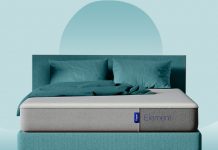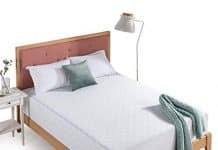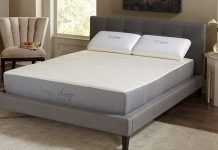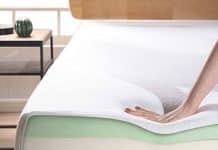If you’re dealing with the unwelcome presence of bed bugs in your mattress, you’re probably eager to find a solution that ends these pesky creatures. We understand the frustration and discomfort of sharing your bed with these unwanted guests.
In this article, we will explore effective methods and practical tips to help you get rid of bed bugs from your mattress so you can enjoy a peaceful and bug-free sleep again.
Review contents
Inspecting for Bed Bugs
Identifying the Signs of Bed Bugs
When dealing with a potential bed bug infestation, the first step is identifying these pesky insects’ signs. Bed bugs leave behind several telltale signs, including red, itchy bites on the skin, bloodstains on sheets and pillows, and tiny dark spots on bedding or furniture.
Using a Flashlight and Magnifying Glass
To inspect for bed bugs, having the right tools on hand is essential. A flashlight and magnifying glass can be extremely helpful in detecting these elusive pests. The flashlight will provide sufficient lighting to spot bed bugs in dark corners or crevices, while the magnifying glass will magnify the insects, making them easier to identify.
Searching for Live Bed Bugs and Their Eggs
Inspecting for bed bugs requires thoroughly searching the mattress, box spring, and surrounding areas. Start by carefully examining the seams and folds of the mattress and the area between the mattress and box spring. Look for live bed bugs, which are reddish-brown and about the size of an apple seed, as well as their tiny white eggs.
Looking for Bed Bug Fecal Stains
Another key indicator of a bed bug infestation is the presence of fecal stains. Bed bugs leave dark brown or black stains on bedding, mattresses, or furniture due to their digested blood. These stains may resemble small dots or smears and can be found on sheets, pillowcases, or mattress seams.
Detecting a Musty Odor
Bed bugs also emit a distinct musty odor, often described as a sweet, sickly scent. If you notice an unusual smell in your bedroom, especially around the mattress or furniture, it could indicate a bed bug infestation. Be sure to check for other signs to confirm the presence of bed bugs.
Preparing the Mattress for Treatment
Removing Bedding and Linens
Before starting any treatment, removing all bedding and linens from the mattress is essential. This includes sheets, pillowcases, blankets, and mattress covers. Place these items in sealed plastic bags to prevent bed bugs from spreading to other areas of your home.
Encasing the Mattress and Box Spring
Consider encasing them in specialized bed bug-proof covers to prevent further infestation and protect your mattress and box spring. These covers are durable, tightly woven fabric that bed bugs cannot penetrate. Encasing your mattress and box spring creates a physical barrier that traps any existing bed bugs inside, preventing them from feeding and eventually killing them.
Vacuuming the Mattress Thoroughly
Vacuuming your mattress is an essential step in preparing for bed bug treatment. Use a vacuum cleaner with a brush attachment to thoroughly clean all sides of the mattress, paying close attention to seams, crevices, and tufts. This will help remove bed bugs, their eggs, and debris, making the following treatment more effective.
Cleaning and Decluttering the Surrounding Area
In addition to preparing the mattress, it’s crucial to clean and declutter the surrounding area. Remove any items stored under or near the bed, such as clothing, shoes, or toys. Vacuum the floor, baseboards, and any furniture adjacent to the bed to eliminate any potential hiding spots for bed bugs.
Sealing Cracks and Crevices
Bed bugs can hide in tiny cracks and crevices, making it essential to seal these entry points. Inspect the walls, baseboards, and furniture for cracks or openings, and use caulk or sealant to seal them shut. This will prevent bed bugs from accessing your mattress and other areas of your home.
Natural Remedies for Bed Bug Removal
Using High Heat Treatment
High heat is an effective natural remedy for killing bed bugs and their eggs. Wash your infested bedding and clothing in hot water and then dry them on the highest heat in your dryer for at least 30 minutes. You can also use a steam cleaner to treat your mattress, furniture, and other infested areas with high heat.
Freezing the Bed Bugs
Extreme cold temperatures can also be used to kill bed bugs. If you have items that cannot be washed, such as books or electronics, you can seal them in a plastic bag and place them in the freezer for several days. This will freeze and kill any bed bugs and their eggs.
Using Diatomaceous Earth
Diatomaceous earth is a natural powder from fossilized algae that can eliminate bed bugs. Sprinkle a thin layer of diatomaceous earth around the perimeter of your mattress, box spring, and other infested areas. The microscopic particles will penetrate the bed bugs’ exoskeleton, causing them to dehydrate and die.
Applying Essential Oils
Certain essential oils, such as lavender, tea tree, and peppermint oil, have been known to repel bed bugs and can be used as a natural deterrent. Mix a few drops of your chosen essential oil with water or carrier oil, such as coconut oil, and spray it around your mattress, bedding, and furniture to discourage bed bugs from infesting these areas.
Sprinkling Baking Soda
Baking soda can help eliminate bed bugs by dehydrating them. Sprinkle a generous amount of baking soda on your mattress, focusing on any visible bed bug clusters or areas of infestation. Leave it for a few hours, then vacuum it up thoroughly. Repeat this process several times to enhance the effectiveness of the treatment.
Chemical Treatments for Bed Bug Eradication
Choosing an Appropriate Insecticide
When natural remedies are not yielding the desired results, chemical treatments can be an effective option for bed bug eradication. Choosing an insecticide specifically formulated for bed bugs and safe for use on mattresses and furniture is crucial. Look for products that contain ingredients like pyrethroids or neonicotinoids.
Following the Manufacturer’s Instructions
Before applying any insecticide, carefully read and follow the manufacturer’s instructions. Pay close attention to application methods, recommended dosage, and safety precautions. Wearing protective gear, such as gloves and a mask, is also essential to minimize the potential risks of using insecticides.
Applying the Insecticide to Infested Areas
Using a spray bottle or applicator, apply the insecticide to infested areas, such as mattress seams, cracks, and crevices. Be thorough and ensure the insecticide reaches all potential hiding spots for bed bugs. Avoid oversaturation, as excessive moisture can mold or damage your mattress.
Treating Surrounding Areas and Furniture
Bed bugs can quickly spread from your mattress to other areas of your home. Therefore, it’s crucial to treat other infested areas, such as furniture, baseboards, and carpeting, with the appropriate insecticide. Thoroughly clean and vacuum these areas before application to maximize the effectiveness of the treatment.
Considering Professional Extermination Services
If the infestation persists despite your best efforts, it may be time to consider professional extermination services. Professional exterminators have the knowledge and experience to eliminate bed bugs effectively. They can offer various treatment options, including chemical and heat treatments, tailored to your situation.
Heat Treatment Methods
Using Steam to Kill Bed Bugs
Steam treatment is an effective method for killing bed bugs and their eggs. Use a handheld or professional-grade steamer to treat your mattress, furniture, and other infested areas. The high temperatures of the steam will effectively eradicate bed bugs, while the moisture helps penetrate fabric and crevices.
Using a Clothes Dryer
If you have items that cannot withstand high heat treatment, such as shoes or delicate fabrics, you can use a clothes dryer to eliminate bed bugs. Place the infested items in a dryer on the highest heat setting for at least 30 minutes. This will ensure that the heat reaches lethal temperatures for bed bugs.
Hiring Professional Heat Treatment Services
Professional heat treatment services use specialized equipment to raise the temperature of a room or an entire structure to levels lethal to bed bugs. The process typically involves heating the space to around 120 to 140 degrees Fahrenheit and maintaining that temperature for several hours. Professional heat treatment effectively eradicates bed bugs in all life stages.
Using a Portable Heat Chamber
Using a portable heat chamber is a viable option for smaller infested items that cannot tolerate high heat, such as electronics or delicate fabrics. Place the items inside the heat chamber; elevated temperatures will kill the bed bugs and their eggs. Portable heat chambers are available for purchase or rent.
Avoiding Extreme High Temperatures for Mattress Safety
While heat treatment effectively eliminates bed bugs, it’s essential to use caution when exposing your mattress to extremely high temperatures. Excessive heat can damage mattresses and may pose a fire hazard. Always follow the manufacturer’s recommendations for safe heat levels and duration to protect your mattress and home.
Prevention Strategies
Regularly Cleaning and Inspecting the Mattress
To prevent future bed bug infestations, it’s essential to maintain a regular cleaning and inspection routine for your mattress. Vacuum your mattress thoroughly, paying attention to seams and crevices, and inspect it for any signs of bed bugs or their eggs. Promptly address any issues to prevent a full-blown infestation.
Using Mattress Encasements
Investing in high-quality mattress encasements is an effective preventive measure against bed bugs. These encasements create a protective barrier around your mattress, preventing bed bugs from infesting or escaping. Be sure to choose encasements designed explicitly for bed bug prevention and that are durable and tightly woven.
Reducing Clutter in the Bedroom
Bed bugs thrive in cluttered environments, as they provide them with numerous hiding spots. To minimize the risk of infestation, keep your bedroom tidy and clutter-free. Regularly declutter and organize your belongings, paying particular attention to areas near the bed and furniture.
Sealing Cracks and Openings
Sealing cracks and openings is essential in preventing bed bugs from entering your home. Inspect your walls, baseboards, and furniture for cracks or openings and seal them shut using caulk or sealant. You significantly reduce the chances of a bed bug infestation by eliminating potential entry points.
Avoiding Secondhand Furniture
One common way that bed bugs enter homes is through secondhand furniture. If you’re considering purchasing used furniture, inspect it thoroughly for any signs of bed bugs or their eggs. It’s also advisable to treat the furniture with heat or insecticides before bringing it into your home to ensure it is bed bug-free.
Professional Bed Bug Removal Services
Understanding the Benefits of Professional Services
Professional bed bug removal services offer a range of benefits for homeowners dealing with an infestation. These professionals have the knowledge and expertise to eliminate bed bugs effectively, often using combination treatments. They can provide a customized approach to tackle even the most stubborn infestations.
Evaluating Pest Control Companies
When selecting a pest control company, it’s crucial to do your due diligence. Research different companies, read customer reviews, and compare their treatment methods and pricing. Look for companies with experience in bed bug removal and certifications from reputable organizations.
Preparing for Professional Treatment
Before professional treatment, it’s essential to prepare your home adequately. Follow the instructions provided by the pest control company, which may include tasks such as washing and bagging clothing and linens, removing clutter, and ensuring good access to infested areas. Proper preparation ensures that the treatment is as effective as possible.
Considering Different Treatment Options
Professional bed bug removal services offer various treatment options tailored to your situation. These may include chemical treatments, heat treatments, or a combination. Discuss the pros and cons of each method with the exterminator and choose the most suitable option based on the extent of the infestation and your specific needs.
Following Post-Treatment Instructions
After professional treatment, it’s essential to follow any post-treatment instructions provided by the exterminator. This may include avoiding certain areas of your home for a specified time, washing and drying linens on high heat, or scheduling follow-up visits. Adhering to these instructions will help ensure the long-term success of the treatment.
Treating Other Infested Items
Cleaning and Treating Bedding and Linens
Bedding and linens are familiar hiding places for bed bugs, so cleaning and treating them properly is crucial. Wash infested bedding and linens in hot water using the highest available heat. Dry them on high heat for at least 30 minutes to kill any remaining bed bugs or eggs. Consider using bedbug-proof covers for future protection.
Treating Clothing and Fabrics
Bed bugs can also infest clothing and fabrics, so addressing these items is essential. Place infested clothing in sealed plastic bags and wash them in hot water. Dry them on high heat or the highest setting your fabrics can tolerate. Consider using a fabric-safe insecticide spray for delicate fabrics or items that cannot be washed.
Inspecting and Treating Furniture
Bed bugs often hide in furniture, so inspecting and treating infested pieces is crucial. Thoroughly inspect all crevices, seams, and cracks in furniture, and use a vacuum cleaner to remove any visible bed bugs or eggs. Consider using a specialized insecticide labeled for furniture treatment, following the manufacturer’s instructions.
Dealing with Carpet Infestations
Taking immediate action is essential if you suspect bed bugs in your carpet. Vacuum the carpet thoroughly, paying particular attention to the edges and corners. Use a stiff brush to loosen any bed bugs or eggs from the fibers. Consider using a specialized carpet insecticide or steam cleaner to treat the infested areas.
Addressing Infested Electronics and Books
Bed bugs can hide in electronics and books, making them challenging to treat. Use a soft brush or cloth to remove any visible bed bugs or eggs for electronics. Consider using a specialized bed bug spray formulated for electronics. Inspect books for signs of infestation and place them in sealed plastic bags. Freeze the bags for several days or use a specialized book treatment method.
Safety Considerations
Using Protective Gear
When dealing with bed bugs and applying treatments, it’s essential to protect yourself. Wear gloves, a mask, and protective clothing to minimize skin contact and prevent potential allergic reactions or irritations. Follow all safety precautions outlined by the product manufacturer or pest control professional.
Reading and Following Product Labels
Always read and follow the instructions on product labels. Pay close attention to usage guidelines, recommended safety measures, and proper disposal methods. Proper application and adherence to product instructions ensure effective treatment while minimizing potential risks to yourself, others, and the environment.
Proper Ventilation and Air Circulation
When using chemical treatments, ensure proper ventilation and air circulation in the treated areas. Open windows and doors, use fans and avoid spending extended periods in treated spaces. Adequate ventilation helps dissipate any odors or fumes associated with the treatments and reduces the risk of respiratory issues.
Keeping Children and Pets Away from Treated Areas
It’s crucial to keep children and pets away from treated areas during and after treatment. Restrict access to your home’s treated rooms or sections until the products have dried or any necessary waiting period has elapsed. This prevents accidental exposure or ingestion of the treatments, ensuring the safety of your loved ones.
Seeking Medical Advice for Allergic Reactions
If you experience any allergic reactions, skin irritations, or other adverse effects resulting from bed bug treatments, it’s essential to seek medical advice. Consult a healthcare professional promptly to ensure appropriate treatment and prevent further complications. Allergic reactions to bed bug treatments can vary in severity, so addressing them promptly is crucial.
When to Seek Professional Help
Persistent or Worsening Infestations
If your efforts to eliminate bed bugs have been unsuccessful, and the infestation persists or worsens, it’s time to seek professional help. Pest control professionals have the expertise and resources to tackle even the most stubborn infestations and can provide you with a customized treatment plan for effective eradication.
Multiple Infested Rooms or Areas
If bed bugs have spread to multiple rooms or areas of your home, professional help is highly recommended. The extensive nature of the infestation requires comprehensive treatment and thorough inspection to ensure that all bed bugs are eradicated. Professional exterminators have the necessary equipment and knowledge to handle such complex situations effectively.
Ineffective Home Remedies
If your attempts at home remedies and DIY treatments have not yielded the desired results, you should turn to professional bed bug removal services. Professional exterminators have access to more vital, more effective treatments that can eliminate even the most stubborn infestations. Don’t hesitate to seek professional help when your home remedies prove ineffective.
Health Concerns or Allergic Reactions
If you or anyone in your household experiences health concerns, allergic reactions, or adverse effects from bed bug bites or treatments, consult a healthcare professional. Bed bug bites can cause skin irritations, allergic reactions, or secondary infections. It’s essential to address any health concerns promptly to ensure proper treatment and prevent further complications.
Extensive Damage to Furniture or Property
If your furniture or property has suffered extensive damage due to a bed bug infestation, professional help may be necessary. Bed bugs can cause significant damage to furniture, mattresses, and other belongings. Professional exterminators can assess the extent of the damage and guide restoration or replacement options.































